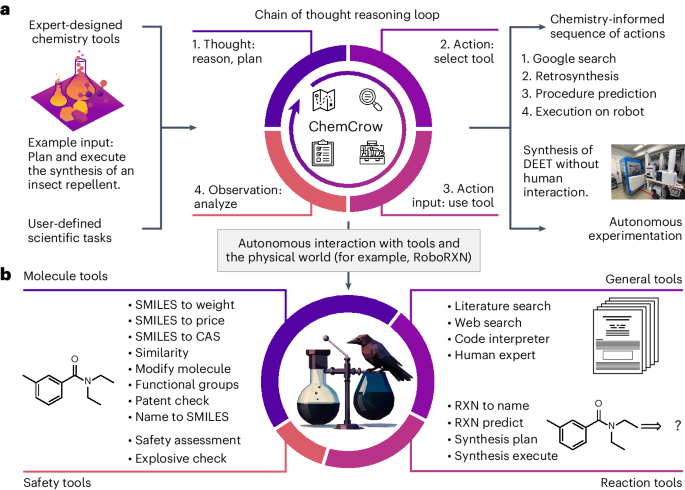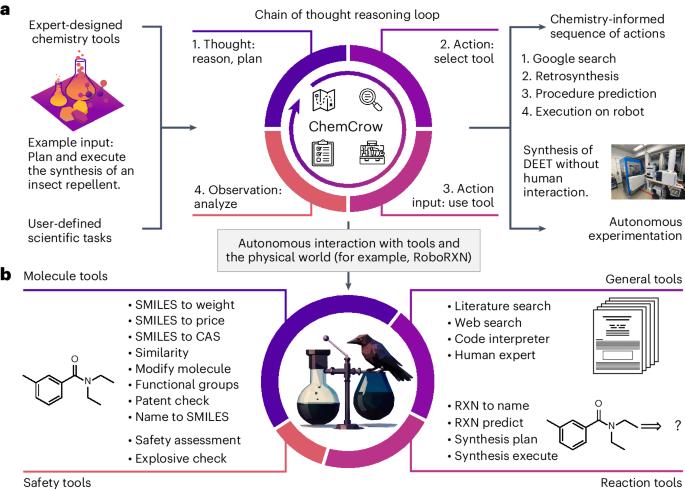用化学工具增强大型语言模型
IF 18.8
1区 计算机科学
Q1 COMPUTER SCIENCE, ARTIFICIAL INTELLIGENCE
引用次数: 0
摘要
大型语言模型(LLMs)在各领域的任务中表现出很强的性能,但在处理与化学有关的问题时却举步维艰。这些模型还无法访问外部知识源,限制了它们在科学应用中的实用性。我们介绍的 ChemCrow 是一种 LLM 化学代理,旨在完成有机合成、药物发现和材料设计等任务。通过集成 18 种专家设计的工具并使用 GPT-4 作为 LLM,ChemCrow 增强了 LLM 在化学领域的性能,并产生了新的能力。我们的代理自主规划并执行了一种驱虫剂和三种有机催化剂的合成,并指导发现了一种新型发色团。我们的评估(包括 LLM 和专家评估)证明了 ChemCrow 在自动完成各种化学任务方面的有效性。我们的工作不仅为专家化学家提供了帮助,降低了非专家的门槛,还通过弥合实验化学与计算化学之间的差距促进了科学进步。本文章由计算机程序翻译,如有差异,请以英文原文为准。


Augmenting large language models with chemistry tools
Large language models (LLMs) have shown strong performance in tasks across domains but struggle with chemistry-related problems. These models also lack access to external knowledge sources, limiting their usefulness in scientific applications. We introduce ChemCrow, an LLM chemistry agent designed to accomplish tasks across organic synthesis, drug discovery and materials design. By integrating 18 expert-designed tools and using GPT-4 as the LLM, ChemCrow augments the LLM performance in chemistry, and new capabilities emerge. Our agent autonomously planned and executed the syntheses of an insect repellent and three organocatalysts and guided the discovery of a novel chromophore. Our evaluation, including both LLM and expert assessments, demonstrates ChemCrow’s effectiveness in automating a diverse set of chemical tasks. Our work not only aids expert chemists and lowers barriers for non-experts but also fosters scientific advancement by bridging the gap between experimental and computational chemistry. Large language models can be queried to perform chain-of-thought reasoning on text descriptions of data or computational tools, which can enable flexible and autonomous workflows. Bran et al. developed ChemCrow, a GPT-4-based agent that has access to computational chemistry tools and a robotic chemistry platform, which can autonomously solve tasks for designing or synthesizing chemicals such as drugs or materials.
求助全文
通过发布文献求助,成功后即可免费获取论文全文。
去求助
来源期刊

Nature Machine Intelligence
Multiple-
CiteScore
36.90
自引率
2.10%
发文量
127
期刊介绍:
Nature Machine Intelligence is a distinguished publication that presents original research and reviews on various topics in machine learning, robotics, and AI. Our focus extends beyond these fields, exploring their profound impact on other scientific disciplines, as well as societal and industrial aspects. We recognize limitless possibilities wherein machine intelligence can augment human capabilities and knowledge in domains like scientific exploration, healthcare, medical diagnostics, and the creation of safe and sustainable cities, transportation, and agriculture. Simultaneously, we acknowledge the emergence of ethical, social, and legal concerns due to the rapid pace of advancements.
To foster interdisciplinary discussions on these far-reaching implications, Nature Machine Intelligence serves as a platform for dialogue facilitated through Comments, News Features, News & Views articles, and Correspondence. Our goal is to encourage a comprehensive examination of these subjects.
Similar to all Nature-branded journals, Nature Machine Intelligence operates under the guidance of a team of skilled editors. We adhere to a fair and rigorous peer-review process, ensuring high standards of copy-editing and production, swift publication, and editorial independence.
 求助内容:
求助内容: 应助结果提醒方式:
应助结果提醒方式:


